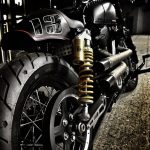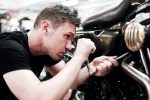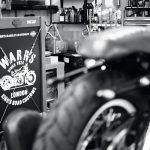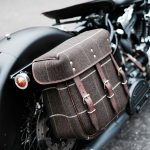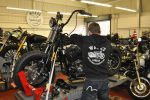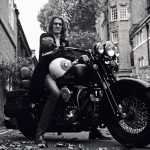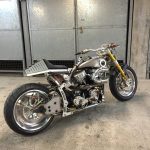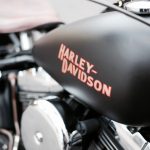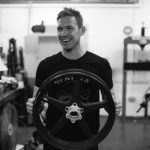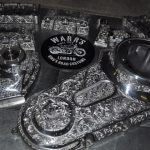News
Charlie Stockwell – Two-Wheeled Da Vinci
Stockwell represents an all-new breed of bike designer — one that intentionally works from within the system, so that the bikes he builds will retain their Harley-Davidson factory warranty. Stockwell almost singlehandedly ushered in the era of the modern bobber with his contemporary homage to stripped-down, rigid-framed “chopped” Harley Knuckleheads from the 1940s. At the same time, he has become the master of Grand-Prix-styled Dynas and Sportsters, merging their timeless iconography with high-performance Ohlins suspension, Brembo brakes and race-tuned engines. By the time you read this, he has already become one of the most coveted motorcycle design Svengalis, a rock star within his industry, which makes his unabashed humility all the more charming. It was my pleasure to engage in Artistotelian discourse with Stockwell to find out what he feels is the future of custom motorcycling.
It’s really interesting how tastes shift organically related to what’s happening in motorcycle culture. The hooligan stunt scene in the West Coast of the US is a huge influence right now and, as a result, Dynas in the US are sold out. People want inverted front ends and Ohlins rear shocks and they want these big, kind of ugly police fairings from the 1980s. You’ve got stunt riders pulling stoppies and wheelies, so they want optimum performance products but they want it to look cool too.
You were the first person I ever saw using Swedish suspension company Ohlins’s race-bike shocks on a Harley. How did this come about?
Ohlins saw a bike I was building that used their racing fork and shocks, and they said, “Those shocks cost 1,200 pounds — you can’t put those on a Harley.” But then they paused and said, “But we think it’s kind of cool.” Today, I design a line of shocks together with them and influenced them to create their blacked-out shocks.
But why put expensive performance components on Harleys?
Harleys have always been the most iconic motorcycles. Performance has been there to some extent, but that has never been the objective. For example, the best handling Big Twin Harley — the FXR — came out in the ’80s, but it has long since been discontinued. So the idea was to take the motorcycles and, while retaining all the integrity of their character, bring them to the highest performance abilities possible. I’ve always loved MotoGP. And when I got into this job, I thought, “You’ve got guys riding Ducati and Yamahas trying to make them the very best for the racetrack. And then you’ve got the stereotypical Harley of the ’90s with loud paint, lots of chrome and wide tires and I thought, “Let’s try doing exactly the opposite. Let’s make them ride incredibly well and look totally different.”
We are willing to go as far as the customer wants, yet give them the reassurance of a Harley warranty on their motorcycle. What we do is, mechanically, we keep the bikes 100-percent Harley on the inside. So, even if your bike looks incredibly custom, you could take it to any Harley service center in the world and they would know what to do with it.
How much can you push the performance of a Harley-Davidson?
If you want more performance from the motor, Harley offers so many different packages. If you want to go really extreme, you can even install a race engine built by the head of our race program. You can have a 1,250cc motor with twin spark heads that take a lot of tuning but are really incredible. What’s nice about Warr’s is that we’ve been involved in racing since the ’80s. John Warr [managing director of Warr’s] was really enthusiastic about this. He was really competitive and was always of the thought that if you’re really good, you should win your first race. He was extremely competitive and really skilled. So then we started hiring pro racers and entered the Daytona 200 and we’d rock up from London and kick some ass in America. And so the technology we are installing on your bike comes from real racing; it is functional and reliable.
How did you get started working with motorcycles?
I had a Saturday job here at Warr’s back when I was 16 years old. I was studying art and graphic design. I used to make the guys coffee and sweep the floor and clean the bikes, which I still do. (Laughs) One thing I realized during school was, I couldn’t understand how people could grade art. For me, no one is a bad artist. I told my teacher, “Don’t grade me. I won’t continue with university.” So I started working full-time at Warr’s — first, as an apprentice. My brother-in-law worked here too, and I really liked it. The guys were really good to me; they trained me up, and I went to Milwaukee and then to Germany for the Harley-Davidson University. Now, they have a facility in Birmingham, and I go regularly. You need to understand how each new bike is designed in order to redesign it. After three or four years, I was itching to be creative. So I asked the bosses here if I could build a custom bike. At the time, there was no custom scene here; it was only what we saw in magazines from the States. This was 16 years ago. They were a bit reluctant but eventually let me build a bike, which turned out to be something very typical of the ’90s. Then someone from South Africa saw it and bought it.
How did you get known for building some of the first modern bobbers?
I started thinking, “What do I really like?” and I started to focus on vintage bikes, specifically bobbers, and how we could make a modern bike look like one of these old stripped-down rigid-framed Harley Knuckleheads. Back in the day, this was the way they customized Harleys. There wasn’t custom product to put on them, so they modified them by taking things off to make them lighter and handle better. They would take the rear fender off at the hinge, take off the roll bars — all the non-essential stuff — and reduce the bike to its bare minimum. Initially, we made a lot of these based on Springer Softails, as this model didn’t sell well in the UK.
Is it true your bikes inspired Harley-Davidson?
(Chuckles) Eventually, Harley ended up making their own bobber-styled bike with a springer front end called the Crossbones. At some point, they inferred that it was inspired by the bikes we were creating.
Why get a modern bike styled like a vintage bike?
The vintage bikes are great but you have to tend to them all the time. On these modern bobbers, you can jump on them and they start every time, they have brakes that work, they don’t leak oil — you have all of the modern advantages of a new bike, including the factory warranty. We can fabricate almost any part for these bikes so the self-expressive potential is huge.
When did you start focusing on the performance-themed bikes?
Back then I was thinking, “We need to do something different. We don’t want to be pigeonholed.” Then I thought, “Well, no one is doing MotoGP-styled Harleys. We have had this incredible race program, so let’s start doing these kinds of bikes.”
I love Sportsters, especially the ones they are producing now with the Dark Custom line, the 48 and the Roadster. Right out of the box, they look cool, which tends to make my job a little bit easier. The Sportster is our best-selling bike and you don’t have to do a lot to them to make them look ultra-cool. I think it’s because the original silhouette is so iconic. At the same time, it’s such a light, nimble bike that when you put the performance products on it, you really change the handling. And most importantly, it’s the bike that appeals most to young people, and we need to connect with the next generation of customer. We need to connect with female customers too. Look at the Roadster with its sport-bike inverted front end. It’s not the bike that the middle-aged guy with the bald head and the beard is riding. So, by enabling modification and personalization of the Sportster range, you bring the values of Harley to a new customer group.
How does a person’s personality come through in their bike?
I have a customer that has a Fat Boy and he wanted to buy his wife a Sportster. The job was to look at her and create a bike that portrayed her personality and identity without her having to explain anything. So I looked at the way she dressed and carried herself and what kind of watch she wore. I realized I wanted a warm-looking bike. I refinished the engine in a champagne nickel, created a paint job that was subtle but really came to life in the sunlight, and I used a copper-nitride coating on the front forks all to give this sense of timelessness and warmth to the bike. I also used a few brass components to give the bike a simultaneously modern and retro look.
You mention watches — do you like them?
Watches have always fascinated me. It’s about fine detail. How watchmakers go about designing watches is very similar to how we go about designing our bikes. Everything has to be beautiful, but it also has to be 100-percent functional. I particularly like Hublot. It has this cutting-edge sense of performance and rawness to it. You see a Hublot across the room and it has this great attitude and a luxury industrial aesthetic. I like being able to see how gears and wheels interact in engines so I really like tourbillons. I like that every element you see has a true purpose.
I have a customer that is a young, very cool guy from Russia. He came in wearing a Richard Mille sapphire tourbillon. He loved racing cars and his favorite color was blue. He wanted to create the ultimate Sportster. A bike that in one look captured his love for auto racing. So we created a bike using the Ohlins suspension and a race engine. Then we had BST [Blackstone Tek] make us a set of custom carbon-fiber wheels using our hub width measurement. It was really important to reduce unsprung weight and these wheels completely transformed the handling. Combined with the powerful engine, they are a real revelation. We blue-ceramic-coated a Rough Crafts exhaust and we did a gray-blue matte digital camouflage paint on the tank.
Is it true that you’ve built a bike for Jenson Button?
I’ve actually built two bikes for Jenson Button. He explained to me, “If I ever win the championship I’ll come here and have you create one for me.” Then he won and so he organized a meeting with Evisu Jeans, which was sponsoring him at the time, and they commissioned me to build him a bike. The idea was to decorate the bike in Japanese tattoo-engraving. Then he fell in love with the bike and said, “I got to buy it.” But I said, “Listen, I would love to build an F1-inspired bike.” At first, he wasn’t so enthusiastic because he didn’t want to link his bike too much to the F1 world, but in the end, he agreed. We got Akebono, the Japanese brake company, to create a unique brake system using titanium monobloc calipers and custom disks and master cylinders. They would fly in from Japan every other month bringing over parts. The bike was ultra-performance.
We have another customer who loves his Singer Porsche. So he said he wanted a bike that from a distance would like a classic Hydra-Glide, but when you got closer, you would realize that it had all the most up-to-date performance parts from Ohlins suspension to Brembo brakes. At the same time, we changed all his hoses to copper pipes to give it a real artisanal feel.
What would be one of your most radical projects?
A bike called the Burning Man for a customer who has the biggest camp in the Burning Man festival called Black Ocean [entrepreneur Timur Sardarov]. He’s a super-cool guy. He said, “Can you create a float for me for Burning Man?” So I replied, “I can’t build a float as I don’t know anything about that. Let me build you a Burning Man bike instead. Something really aggressive and that looks like ‘Mad Max meets Star Wars’.” It features high-performance Ohlins suspension and raw bodywork with windows in the gas tank. My biggest headache was figuring out how to make these windows work. It was a lot of new practices and techniques. It is really important to us to push what we can do.
Tell me about the bike you built for Huntsman chairman and owner Pierre Lagrange…
It was such a pleasure to build a motorcycle for a man like Pierre. Pierre has been a long-time motorcycling enthusiast and he used to ride with this famous group of actors, which included Lauren Hutton and Jeremy Irons. He has a very sophisticated style. I loved that he drives a vintage Aston Martin DB5 Shooting Brake and so his motorcycle had to be very elegant, timeless with great vintage-inspired styling. The details on the bike are really interesting. For example, his rear fender looks like an old hinged rear fender. In fact, I fabricated it to look like this. I really tried to imagine what Pierre in his capacity as the chairman of Huntsman and as a champion for Savile Row would ride. Pierre famously had the interior of his Aston Martin upholstered in Huntsman check tweed and so we decided to also craft his saddlebags with tweed to match this theme.
Where is the creativity coming from today in terms of bike building?
Interestingly, I think that Europe and Asia now are a little bit more innovative than the United States when it comes to building custom Harley-Davidsons.
Would you say that, today, the custom bike builder has become a celebrity?
Television shows like Biker Build-Off and Orange County Choppers certainly helped custom-motorcycle building be recognized as an art form. Then, the Internet and social media helped to internationalize the culture. We can see what people are doing in different parts of the world and the creative energy is galvanizing. That is very exciting. My second language is Thai and it’s incredible to see how vibrant the motorcycle culture in Thailand is. Friends of mine who run the Indian and Zero Engineering franchises also create festivals for bike culture. It’s also nice to have international competitions like the Battle of the Kings, where dealers all around Europe try to create the best Sportster in their country and from there, the best bike in Europe. We’ve been the UK champs twice in a row.
Which companies do you work with the most for the parts of your bikes?
There are no limits. For example, Pierre’s saddlebags were made by a small family of artisans in Italy who were delighted to be part of the project. I also have relationships with what I feel are the most innovative companies on the scene, including Ohlins, Vance & Hines and Roland Sands. I’ve always been a fan of their work and looked up to them, so it’s nice that they seem to like my work too. And it is nice to be able to exchange ideas on where we see motorcycles evolving in terms of design and style.
Is it true that you have customers coming from around the world to have a Charlie Stockwell custom bike?
We have a lot of international clients. What many of them do is buy the bike at their local Harley dealer then ship it to us. We do the work then ship it back to them. Since the bike is already pre-registered in the right country, this is the easiest and most legitimate way to do it. Probably 40 percent of what we do is for foreign customers.
You do realize a bike made by you is quite collectible…
Maybe. If you say so.
Would you ever work for Harley-Davidson in a design capacity?
It might be interesting to work for a corporation but only if there were no restrictions. If I worked for Harley-Davidson, I would have to build bikes for millions of people and I think that would come with restrictions in terms of what I could do creatively. When I build a bike today, I build it for one person. Possibly you. And as such, we are only limited by what you and I can dream of.





